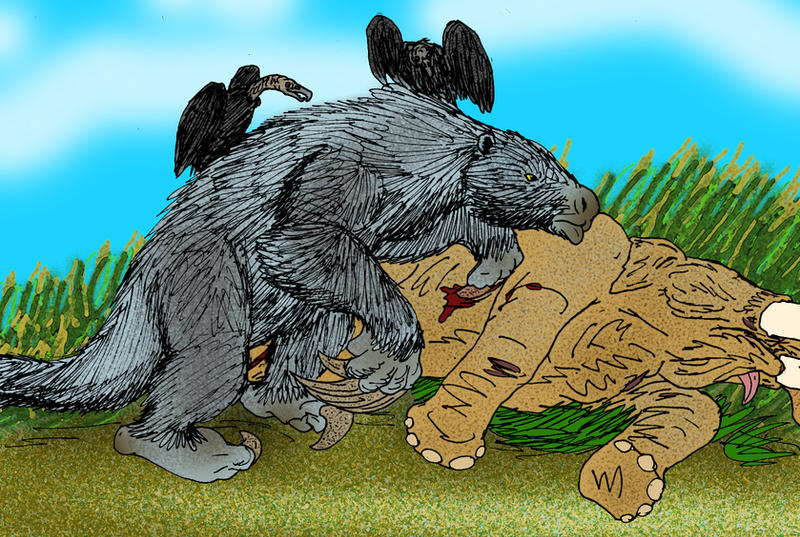Post by Infinity Blade on Apr 30, 2014 6:02:15 GMT 5
Indian Rhinoceros-Rhinoceros unicornis
The Indian rhinoceros (Rhinoceros unicornis), also called the greater one-horned rhinoceros and Indian one-horned rhinoceros, belongs to the Rhinocerotidae family. Listed as a vulnerable species, the large mammal is primarily found in north-eastern India's Assam and in protected areas in the Terai of Nepal, where populations are confined to the riverine grasslands in the foothills of the Himalayas. The Indian rhinoceros once ranged throughout the entire stretch of the Indo-Gangetic Plain, but excessive hunting reduced the natural habitat drastically. Today, about 3,000 rhinos live in the wild, 2,000 of which are found in India's Assam alone. It is the fifth largest land animal. Among terrestrial land mammals native to Asia, the Indian rhinoceros is second in size only to the Asian elephant. This heavily built species is also the second-largest living rhinoceros, behind only the white rhinoceros. Males have an average head and body length of 368–380 cm (12.07–12.47 ft) with a shoulder height of 163–193 cm (5.35–6.33 ft), while females have an average head and body length of 310–340 cm (10.2–11.2 ft) and a shoulder height of 147–173 cm (4.82–5.68 ft). The weights of captive individuals from the Basel Zoo were around 1,600 kg (3,500 lb) on average for the females and around 2,100 kg (4,600 lb) on average for the males. The skull is heavy with a basal length above 60 cm (24 in) and an occiput above 19 cm (7.5 in). The largest sized specimens can range up to 4,000 kg (8,800 lb). The rhino's single horn is present in both males and females, but not on newborn young. The black horn is pure keratin, like human fingernails, and starts to show after about six years. In most adults, the horn reaches a length of about 25 cm (9.8 in), but has been recorded up to 57.2 cm (22.5 in) in length. The nasal horn is slightly back-curved with a base of about 18.5 cm (7.3 in) by 12 cm (4.7 in) that rapidly narrows until a smooth, even stem part begins about 55 mm (2.2 in) above base. In captive animals, the horn is frequently worn down to a thick knob. The Indian rhinoceros has thick, silver-brown skin, which becomes pinkish near the large skin folds that cover its body. Its upper legs and shoulders are covered in wart-like bumps. It has very little body hair, aside from eyelashes, ear fringes and tail brush. Males develop thick neck folds.

Eremotherium eomigrans.
Eremotherium is an extinct genus of ground sloth of the family Megatheriidae, endemic to North America and South America during the Pleistocene epoch. It lived from 4.9 mya—11,000 years ago existing (as a genus) for approximately 4.889 million years. E. rusconi reached a length up to6 m (20 ft) and a weight of more than 3 tons [2.7 metric tons].

Credit goes to avancna for the Eremotherium illustration.
The Indian rhinoceros (Rhinoceros unicornis), also called the greater one-horned rhinoceros and Indian one-horned rhinoceros, belongs to the Rhinocerotidae family. Listed as a vulnerable species, the large mammal is primarily found in north-eastern India's Assam and in protected areas in the Terai of Nepal, where populations are confined to the riverine grasslands in the foothills of the Himalayas. The Indian rhinoceros once ranged throughout the entire stretch of the Indo-Gangetic Plain, but excessive hunting reduced the natural habitat drastically. Today, about 3,000 rhinos live in the wild, 2,000 of which are found in India's Assam alone. It is the fifth largest land animal. Among terrestrial land mammals native to Asia, the Indian rhinoceros is second in size only to the Asian elephant. This heavily built species is also the second-largest living rhinoceros, behind only the white rhinoceros. Males have an average head and body length of 368–380 cm (12.07–12.47 ft) with a shoulder height of 163–193 cm (5.35–6.33 ft), while females have an average head and body length of 310–340 cm (10.2–11.2 ft) and a shoulder height of 147–173 cm (4.82–5.68 ft). The weights of captive individuals from the Basel Zoo were around 1,600 kg (3,500 lb) on average for the females and around 2,100 kg (4,600 lb) on average for the males. The skull is heavy with a basal length above 60 cm (24 in) and an occiput above 19 cm (7.5 in). The largest sized specimens can range up to 4,000 kg (8,800 lb). The rhino's single horn is present in both males and females, but not on newborn young. The black horn is pure keratin, like human fingernails, and starts to show after about six years. In most adults, the horn reaches a length of about 25 cm (9.8 in), but has been recorded up to 57.2 cm (22.5 in) in length. The nasal horn is slightly back-curved with a base of about 18.5 cm (7.3 in) by 12 cm (4.7 in) that rapidly narrows until a smooth, even stem part begins about 55 mm (2.2 in) above base. In captive animals, the horn is frequently worn down to a thick knob. The Indian rhinoceros has thick, silver-brown skin, which becomes pinkish near the large skin folds that cover its body. Its upper legs and shoulders are covered in wart-like bumps. It has very little body hair, aside from eyelashes, ear fringes and tail brush. Males develop thick neck folds.

Eremotherium eomigrans.
Eremotherium is an extinct genus of ground sloth of the family Megatheriidae, endemic to North America and South America during the Pleistocene epoch. It lived from 4.9 mya—11,000 years ago existing (as a genus) for approximately 4.889 million years. E. rusconi reached a length up to

Credit goes to avancna for the Eremotherium illustration.







